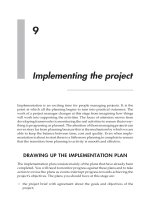Completing the project
Bạn đang xem bản rút gọn của tài liệu. Xem và tải ngay bản đầy đủ của tài liệu tại đây (87.3 KB, 10 trang )
14
Completing the project
As a project nears its completion the focus moves on from implementation
activities to ensuring that all the deliverables have been handed over to the
appropriate recipients. Deliverables are not always tangible products, and
handover may require support or training to enable use of new processes or
technology. Delivery of the outcomes will vary according to the purpose and
objectives of the project, but all the outcomes and deliverables need to be
either formally handed over, or accounted for if anything is missing. The
delivery and handover stage may also include making arrangements to
resolve any difficulties that arise after the project outcomes have been deliv-
ered and everything handed over.
Careful planning is as valuable at the end of the project as it is in the pre-
vious stages. One of the features of a project is that it is intended to achieve
specific objectives, so the end of a project should naturally be with its suc-
cessful conclusion. Lynda Gratton points out that endings can be just as
important as beginnings: ‘Without endings, our companies can look like
archaeological digs made up of layers and layers of past processes and
practices created from the parts of old processes we have never formally
ended’ (Gratton, 2005: 20).
She compares the excitement at the beginning of a project with the emo-
tional sense of loss that a project team often experience when a project has
gone well and achieved its targets successfully, but this also signals the stage
when the team must break up. Planning for and anticipating the end right
from the beginning can bring significant benefits to individuals and
organizations.
HANDOVER AND DELIVERY
The deliverables of a project are usually listed at an early stage of planning.
It is at this stage that arrangements should be made for any conditions that
are necessary for the transfer of responsibility to be completed. For example,
delicate equipment would not normally be handed over until there is a safe
place for it to be installed ready for use. Handover is usually a formal pro-
cedure where the person responsible for accepting the delivery checks every-
thing and ‘signs off’ the item as complete and of the agreed quality. This
process ensures that there is no dispute about whether the project outcomes
have been completed.
Example 14.1
Relocating a joint service
A manager was leading a project to relocate a joint youth centre and
advisory service into part of a new tower block. The project was com-
plex because the new location required different working practices,
particularly for some of the regular services. Handover of all of the
physical aspects of the project, including installation of new partition
walls, furnishing and equipment, was easily managed as each item
could be signed off by the relevant manager. It was more difficult to
make arrangements for the services, including cleaning, electricity,
toilets, lifts and use of the shared ground floor reception area.
After researching how these had been managed in other projects,
the manager devised a chart of required services and worked with
managers of the new joint service area to identify the standards
required of each contracted support service. He then wrote a service
level agreement for each service to be contracted, that set out what
was required. The service level agreement was a document and could
be signed off as a deliverable from the project, and it included details
of the process by which the joint service managers would contract and
regularly review the service standards.
164
Managing projects in human resources
In some projects there are handovers before the conclusion of the project.
These are often between different teams working on sequential tasks.
Although it is not necessary to insist on a formal delivery, some record should
be made in case a dispute arises about where responsibility lies. In some
projects a complete project objective is handed over at an early stage. For
example, a building site may be handed over before any demolition or build-
ing work can begin. The agreements governing the condition in which a site
is handed over can be very complex because some problems can cause sig-
nificant delay. For example, it is a serious problem if asbestos is found during
demolition because specialist services will need time to make the site safe
before any work can continue.
Handovers should have been identified as key stages on the Gantt chart.
If the project involves preparation and handover of a physical object, there
may be a number of contributing components. The project plan will have
identified the various elements and will include details of handover arrange-
ments for each stage if there is a sequence of tasks. The schedule will identify
the sequence in which tasks need to be completed. Hopefully, the risk register
will have identified the risks associated with each handover and a contin-
gency plan will have been made for each major risk.
When the outcome is a physical product it is usually fairly easy to define
the acceptance criteria. It is more difficult to write acceptance criteria for
projects that have developed a new process or service. If the objectives of the
project have been written carefully, the key expectations will be detailed in
a way that helps to identify exactly what should be included in the handover.
It is much better to discuss this in the early stages of planning than to find
that there are different expectations in the final stages of the project. If new
items are added to the deliverables at a late stage it is very difficult to com-
plete the project within the budget and timescales that had been allowed.
If training or support is necessary before the client or sponsor can make
full use of the project outcomes, this should have been anticipated and built
into the project plans. Accepting additional tasks in the late stages can be very
difficult because staff allocated to the project team will often have made
arrangements to move directly on to different work after the completion date
of their contracts.
There are often a number of small tasks or non-urgent details outstanding
as the delivery date approaches. The team leader or project manager should
ensure that someone is responsible for completion of each item and that they
have the means to do the necessary work.
Completing the project
165
DELIVERING WITH STYLE
You can deliver the outcomes agreed with the minimum of fuss or cele-
bration, or you can deliver with style. Most of us would be delighted to
receive a beautifully wrapped gift. A project that meets the outcomes on time
and within the budget will be well received, but if it is well presented it will
enhance the impression of professionalism and care in completing the work.
Each delivery offers an opportunity to please the client with presentation
of a successful outcome. For example, if a project has identified and assem-
bled information that should be available to new members of staff, the project
might be considered to be successfully completed by ensuring that the nec-
essary information is made available. However, a more favourable impres-
sion would be created by handing the induction information to new members
of staff. It might be packaged attractively and contain everything they need
to know, rather than simply notifying new recruits that the information is
available. Even better, the package might be given to them by a member of
the HR staff who explains why they need to know about each item and when
they might need to refer back to the pack, and ideally also offers to answer
any questions. There is an opportunity with the handover events of a project
to create a favourable or unfavourable impression.
PLANNING FOR A SUCCESSFUL CONCLUSION
The successful completion of a project is the purpose of all of the effort and
work, but the end of a project is often a sad event for those who have enjoyed
working together in the project team. A successful project may conclude with
a satisfied client, pleased stakeholders and a proud but sad team! As the team
will disband quickly once the project activities are complete, it is worth
thinking about holding a celebration while it is still intact. Celebration of
success demonstrates confidence in the project. A concluding celebration
can be planned in from an early date. Some teams celebrate each milestone
review.
Celebratory events are usually a motivating factor for the team, giving
momentum in the later stages of a long project. A newssheet and public
announcements can also be effective. Celebrations and announcements give
an opportunity to acknowledge the efforts of the team and contribute to
keeping morale high.
166
Managing projects in human resources
Example 14.2
Closing with an event
A group of young Italian people spent three weeks in the south of
England in work placements that supported them to both improve
their English language skills and to gain some experience of working
in another European country. The work placements were mostly in
the tourist industry and included hotels, tourist offices, restaurants
and travel organizations in a major city.
The agency that had arranged the project planned a closing event
of an evening reception in one of the seafront hotels. The local mayor
agreed to make a speech in support of the project, and many of the
participants prepared short presentations about their experiences and
what they had learnt. The managers from all the work placements
were invited along with the families with whom participants had
stayed and people from other agencies who had contributed to mak-
ing the project a success. The event was a great success and a photo
was published in the local newspaper. The project had been successful
and some friendships were made that continued for many years.
CLOSING THE PROJECT
The closing stage of a project needs planning as carefully as earlier activities.
It is a shame if an otherwise successful project is left in a messy condition
when the members of the project team have to move quickly on to other areas
of work. Once the main purpose of the project has been achieved the tasks of
closure can seem like rather tedious housekeeping. If the project team have
been enjoying the work you might have to make sure that they all stop work-
ing on the project once everything that was part of the agreement has been
delivered. It is always necessary to ensure that payments for time and
expenses are completed and discontinued. The project manager will also
usually be involved in arranging the final review or evaluation.
All projects generate documentation, and the project manager should
ensure that records that might be needed again are stored safely and can be
retrieved. Documents that confirm that all contractual obligations were com-
pleted are kept along with the project plans, budgets and relevant staff
records. The minutes of all major meetings are kept so that agreements that
Completing the project
167









